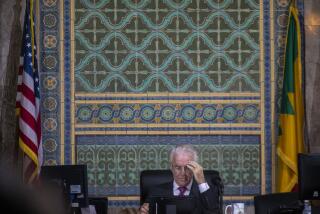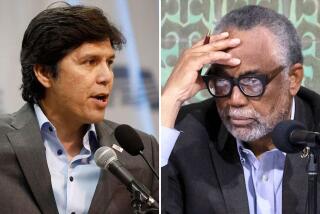Cable Puts Spotlight on Local Officials--But Who’s Watching?
- Share via
It was bad enough to finish second in Irvine’s election for mayor, Barry Hammond thought, walking the golf course late last year with his friend Mike McIntyre. But the third-place candidate, who had dropped out a month before the June elections, got more than 10% of the vote.
“It was very distressing,” remembered McIntyre, a cable television producer. “Someone who is not a candidate wins 3,000 votes? People aren’t awake out there.”
Hammond decided to wake them up--and give himself a little public exposure. With McIntyre’s help, Hammond now hosts his own cable show in the half-hour slot just before Irvine’s City Council meetings are televised. For $100 worth of air time, Hammond kibitzes politics. He tells Irvine cable viewers how the city would run if Barry Hammond were in charge. “It’s a lot of fun,” Hammond said. “My 2 cents’ worth.”
Hammond’s novel show, “Irvine Today,” recognizes an emerging political reality in Orange County: Voters in most cities can now watch local leaders conduct the public’s business on cable television. In exchange for their franchises, cable companies are generally required to show city council meetings. And as more city councils go on the air, cable is slowly changing the way elected officials dress, act, campaign for office and reach out to their constituencies.
But a question remains: Is anybody out there and awake?
Very few, experts say, but no one knows for sure. Ratings services haven’t yet entered the fledgling local cable market, so the impact of city council television is mostly unmeasured. But the political potential of local cable programming could be enormous.
Politicians hope that viewers are tuned in. They know that the people they need spend time glued to their cabled tubes. Studies show that cable subscribers, which make up about half of Orange County’s households, tend to be better educated, richer and more inclined to vote than most.
“It’s a pretty good audience,” said Eileen Padberg, a veteran Republican political consultant in Orange County. “And I think more people are watching.”
Political scholars say cable can open up government, increasing citizen participa-
tion. “Western civilization’s origins came out of the Greek city-state, the concept that educated citizens participate in and observe government,” said Tracy Westen, who teaches communications law at USC. “For the first time, we have a new version of that city-state. All residents of a city can now watch government make those decisions. It demystifies government, and that is important.”
But as that exposure becomes increasingly important to Orange County’s local leaders, they also are realizing it has a flip side. Missteps can turn into major political stumbles.
Westminster Councilman Frank Fry Jr. wasn’t worrying about the council’s first-ever cable broadcast earlier this month. He saw a sparse chamber audience when he urged a Vietnamese military group seeking a parade permit to recognize U.S. holidays instead. “If you want to be South Vietnamese,” Fry said, “go back to South Vietnam.”
“We all kind of gasped a little bit,” said one technician with Rogers Cable TV who was taping the meeting. “That was the first meeting we televised. It’s possible he didn’t realize that.”
The company sold more than a dozen copies of the master tape to incensed Vietnamese groups as the brouhaha unfolded over the next 2 weeks.
“I don’t know whether that live taping of the meeting made any difference,” Fry recalled later. “It sure created a lot of interest in our next meeting, which was rather dull otherwise.”
Other fallouts from cable’s increased presence are less explosive. On the cosmetic side, red ties, blue blazers, bright dresses and pastel suits are more popular with elected officials. Former Huntington Beach Mayor Jack Kelly, once a television actor on the 1950s’ “Maverick” series, took to wearing a more appropriate blazer over his laced, rawhide shirts after the cameras were turned on in the council chambers.
Some cable operators even hand politicians lists of what colors not to wear and how to move before a camera. Blacks, whites and tight arrow patterns are out. No coughing into the microphone or ruffling papers, either.
In Buena Park earlier this year, sensitive microphones picked up two council members whispering as a man approached the dais to speak. “He even looks like a Nazi,” one of the council members said.
And political gadflies can be drawn to the camera’s bright lights. Former Anaheim Mayor Ben Bay kept a 3-minute egg timer in public view as a reminder to would-be windbags.
Sid Soffer, a retired restaurateur and regular at Costa Mesa council meetings, keeps an ever-vigilant eye on the tube when he can’t attend in person.
Exhausted one council night after a 9-hour trip from Reno, he drove by City Hall, “and I said, ‘The hell with it, I’m going home and not worry about it,’ ” Soffer recalled. “I turned on the TV and saw (Mayor) Peter Buffa saying, ‘Sid, if you’re out there, you better get . . . down here.’ So I got out of bed.”
Soffer said people now approach him on the streets to say they recognize him. It’s that kind of visibility that politicians desperately desire. But the problem with local access cable is that no firm tracks viewers in the way that the Nielsen rating service tells advertisers and show producers how many people tune in.
“A lot of local programmers have become savvy and realize the value in determining who is watching,” said C.J. Hirschfield, a vice president for the California Cable Television Assn. in San Francisco. “They build in feedback things, numbers to call. But these (shows) aren’t seen as getting the highest Nielsen ratings.”
In Orange County, estimates of how many subscribers take a look at their city councils in action reaches up to 10%, according to cable operators and other observers.
Few Tune In
Jim Wilson, head of Laguna Video in Laguna Beach, buys unused time from cable operators on their local access channels for his corporate and political clients. He figures that no more than 1% of cable subscribers here watch a given council meeting.
More would watch if the meetings were slickly produced and the operators advertised the channels better, Wilson said. Viewers like local news, he added.
“There’s stuff about the most important town in the whole world,” Wilson said. “Their own town. It’s neat.”
A 1987 study in San Diego found that 18% of cable subscribers watched the City Council meeting at least once in the previous year, said Beth Givens, who is co-writing a book with USC’s Westen on the feasibility of a statewide, government access channel.
But of those, almost all discovered the televised meetings only by chance, “flipping through the dial by serendipity,” Givens said. Only 5% had seen an advertisement.
Cable operators are no longer required by law to provide local government programming, she said. The Cable Communications Act of 1984 struck down federally mandated access channels but allowed local governments to require them in franchise agreements with operators.
More than 120 California communities provide local government programming. And the number continues to grow, Givens said.
MultiVision Cable TV Corp. airs the Anaheim and Villa Park City Council meetings, as well as shows by Anaheim Mayor Fred Hunter and Orange County Supervisor Don R. Roth. It has to, because the franchises require it.
John Merritt, Multivision general manager, concedes that the shows won’t ever bump Geraldo Rivera off the air. “They’d never make it if we had to live by ratings,” he said. “It’s a public service. But we don’t see any negatives. It serves many residents, and as long as it does that, we’ll carry it.”
While television programming of city council meetings is generally free or provided at little cost by the cable system operators, politicians can also buy advertising on local access channels. During elections, cable offers good value for sparse campaign cash, political consultants say.
“It’s a great advertising dollar to spend,” said Padberg, who ran several major city campaigns in Orange County last year and helped with advance work in George Bush’s presidential race.
With no major television station based in Orange County, buying prime time on a Los Angeles channel can cost up to $40,000 for a 30-second spot and be wasted on millions of people who don’t vote here, she said.
“That same ad on cable, depending on how many times it runs, maybe costs $2,500,” Padberg said.
But as more cities televise government meetings and more subscribers presumably pay attention, is a more informed electorate turning out in larger numbers at election time?
National surveys of cable audiences for the sports, news and movies channels such as ESPN, CNN and Showtime found that viewers are politically active, said Lloyd Trufelman, spokesman for the Cable Advertising Bureau in New York City.
Cable viewers are about 25% more likely to have voted or to have worked for a political party or candidate than non-cable viewers, Trufelman said. And they are more than half again as likely to have visited an elected official, he added.
Harvey Englander, a Newport Beach-based political consultant, wants that audience to know his clients. “I buy more and more cable at election times,” he said. “It’s a good addition to direct mail.”
But Englander suspects that the people who watch his ads and the city council meetings on cable are probably the same people voting at election time. Not many non-voters are spending their cable time following politicians.
“I think cable TV is real important for government and politics to come,” Englander said. “Unfortunately, (for now) the people who vote and are involved remain involved. Cable doesn’t have much impact. Those people are already involved.”
TELEVISED CITY COUNCIL MEETINGS IN COUNTY
Here are Orange County cities in which city council meetings are televised, with air days and times. *
Anaheim: Multivision, Channel 22. First and third Mondays of each month at 5:30 p.m. Second and fourth Mondays at 1:30 p.m.
Brea: Century, Channel 3. First and third Tuesdays at 7 p.m.
Buena Park: Comcast, Channel 20. Second and fourth Mondays at 5 p.m.
Costa Mesa: Copley/Colony, Channel 62. First and third Mondays at 6:30 p.m.
Cypress: Copley/Colony, Channel 52. Second and fourth Mondays at 7:30 p.m.
Garden Grove: Rogers, Channel 3A. First and third Mondays at 7:30 p.m.
Huntington Beach: Rogers, Channel 3. First and third Mondays at 7 p.m.
Irvine: Community, Channel 3. Second and fourth Tuesdays at 6:30 p.m.
Laguna Beach: Dimension, Channel 3. First and third Tuesdays at 6 p.m.
Los Alamitos: Rogers, Channel 3A. Second and fourth Mondays at 7 p.m.
Newport Beach: Comcast and Community, Channel 3. Second and fourth Mondays at 7:30 p.m.
Placentia: Comcast, Channel 68. First and third Tuesdays at 7:30 p.m.
San Clemente: Dimension, Channel 3. First and third Wednesdays at 7 p.m.
Santa Ana: Comcast, Channel 3. The first and third Monday meetings are taped and broadcast the following Wednesdays at 6:30 p.m. and at other times.
Seal Beach: Comcast, Channel 3. First and third Mondays at 7 p.m.
Tustin: Community, Channel 3. First and third Mondays at 7 p.m.
Villa Park: Multivision, Channel 22. Third Tuesdays at 7:30 p.m.
Westminster: Rogers, Channel 3. Second and fourth Tuesdays at 7:30 p.m.
* Some tape broadcasts are repeated later in the week.
More to Read
Sign up for Essential California
The most important California stories and recommendations in your inbox every morning.
You may occasionally receive promotional content from the Los Angeles Times.










